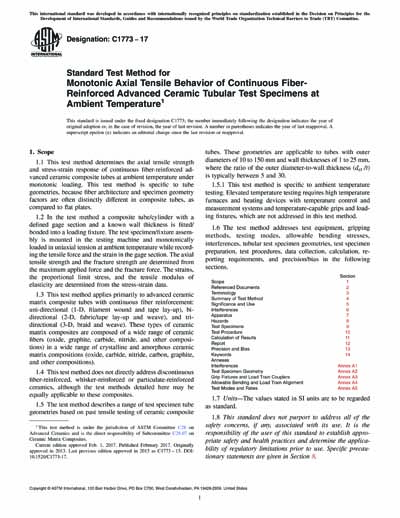Historical
ASTM C1773-17
Standard Test Method for Monotonic Axial Tensile Behavior of Continuous Fiber-Reinforced Advanced Ceramic Tubular Test Specimens at Ambient Temperature
1.1 This test method determines the axial tensile strength and stress-strain response of continuous fiber-reinforced advanced ceramic composite tubes at ambient temperature under monotonic loading. This test method is specific to tube geometries, because fiber architecture and specimen geometry factors are often distinctly different in composite tubes, as compared to flat plates.
1.2 In the test method a composite tube/cylinder with a defined gage section and a known wall thickness is fitted/bonded into a loading fixture. The test specimen/fixture assembly is mounted in the testing machine and monotonically loaded in uniaxial tension at ambient temperature while recording the tensile force and the strain in the gage section. The axial tensile strength and the fracture strength are determined from the maximum applied force and the fracture force. The strains, the proportional limit stress, and the tensile modulus of elasticity are determined from the stress-strain data.
1.3 This test method applies primarily to advanced ceramic matrix composite tubes with continuous fiber reinforcement: uni-directional (1-D, filament wound and tape lay-up), bi-directional (2-D, fabric/tape lay-up and weave), and tri-directional (3-D, braid and weave). These types of ceramic matrix composites are composed of a wide range of ceramic fibers (oxide, graphite, carbide, nitride, and other compositions) in a wide range of crystalline and amorphous ceramic matrix compositions (oxide, carbide, nitride, carbon, graphite, and other compositions).
1.4 This test method does not directly address discontinuous fiber-reinforced, whisker-reinforced or particulate-reinforced ceramics, although the test methods detailed here may be equally applicable to these composites.
1.5 The test method describes a range of test specimen tube geometries based on past tensile testing of ceramic composite tubes. These geometries are applicable to tubes with outer diameters of 10 to 150 mm and wall thicknesses of 1 to 25 mm, where the ratio of the outer diameter-to-wall thickness (dO /t) is typically between 5 and 30.
1.6 The test method addresses test equipment, gripping methods, testing modes, allowable bending stresses, interferences, tubular test specimen geometries, test specimen preparation, test procedures, data collection, calculation, reporting requirements, and precision/bias in the following sections.
1.7 Units—The values stated in SI units are to be regarded as standard.
1.8 This standard does not purport to address all of the safety concerns, if any, associated with its use. It is the responsibility of the user of this standard to establish appropriate safety and health practices and determine the applicability of regulatory limitations prior to use. Specific precautionary statements are given in Section 8.
Content Provider
ASTM International [astm]






